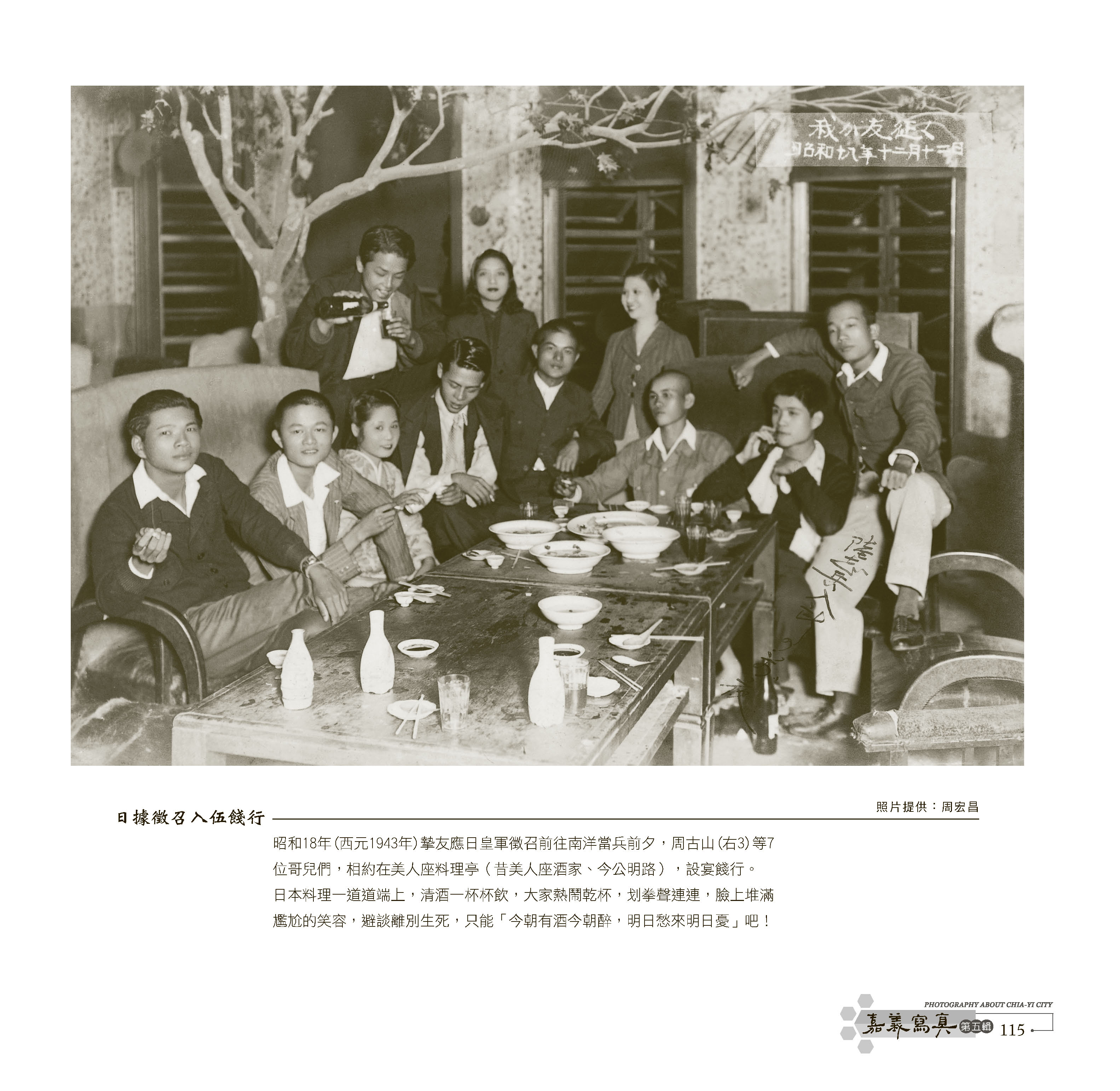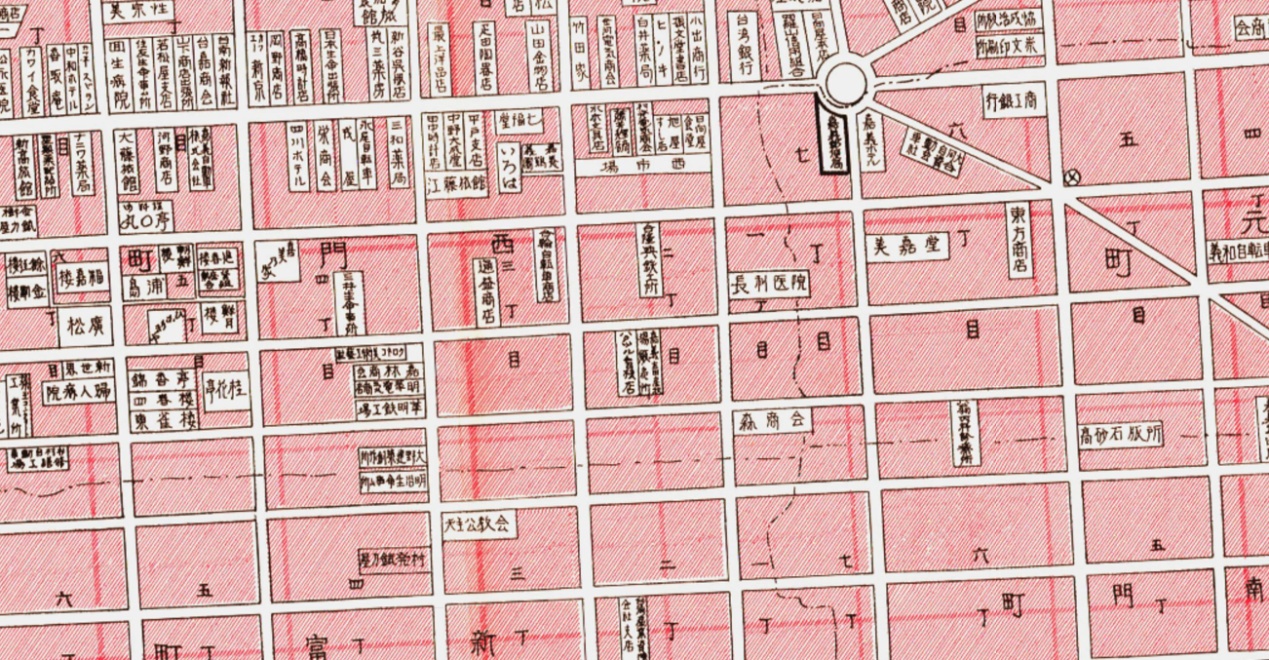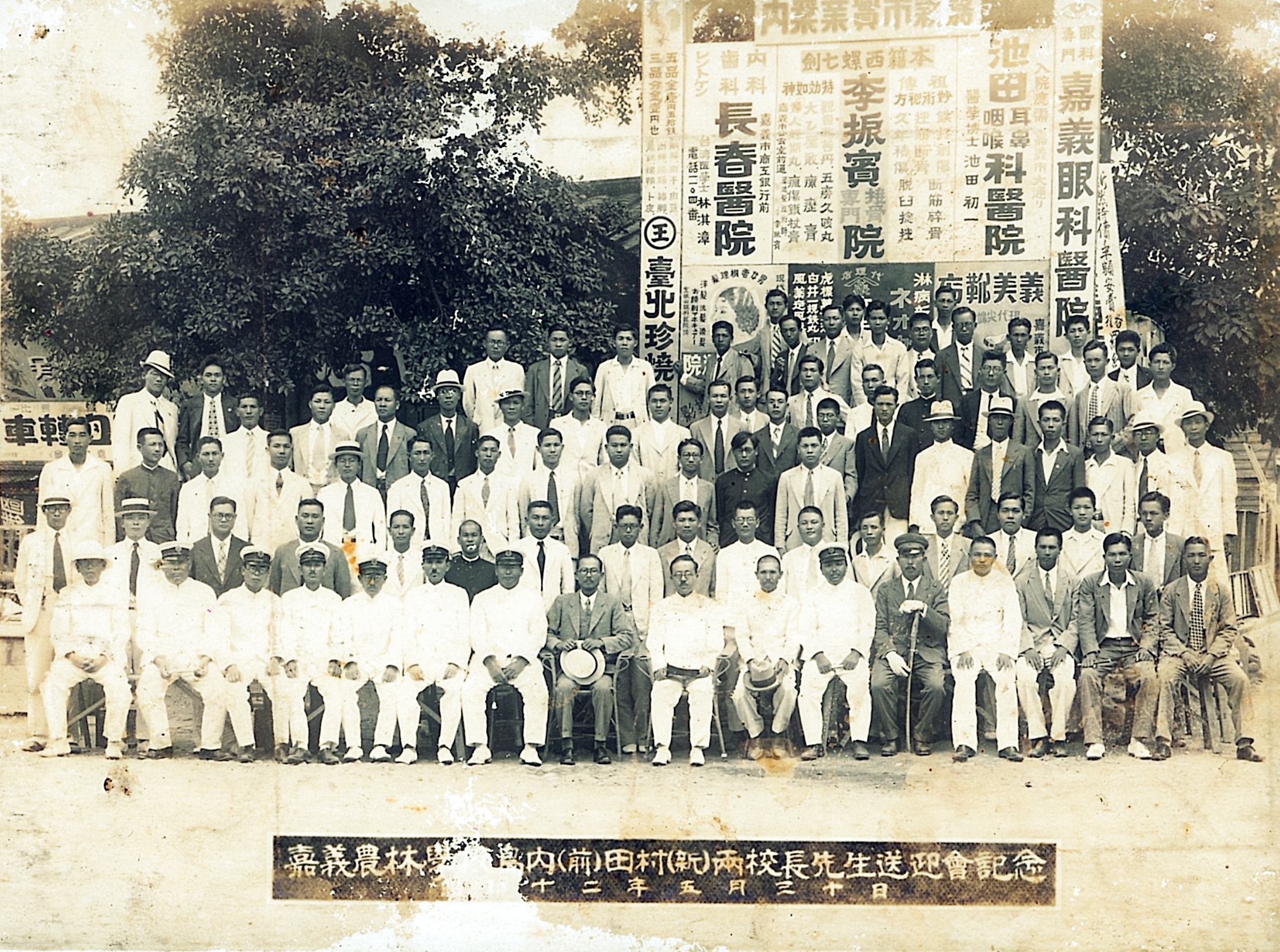西薈芳
為提供使用者有文書軟體選擇的權利,本文件為ODF開放文件格式,建議您安裝免費開源軟體 ([連結])

西薈芳
Xihuifang
西薈芳
1932, 畫布油彩, 117×91cm
oil on canvas
画布油彩
南國豔陽下,枝葉繁茂的大樹給往來行人提供了一方遮蔭,滿載果物、販賣冰品的攤車,似也提示著熱帶島嶼的氣候炎熾。和服、旗袍、洋裝,將不同文化脈絡穿著為衣裳的三個女人,在市街裡交穿而過。挑著擔子微微佝僂的勞動者,則是這片土地上最常見的樸拙身影。西薈芳的午後寧靜安好,但畫中暗藏的語彙其實各自有聲,各自低吟。
In the shade cast by a grand leafy tree, pedestrians stroll past peddlers’ carts loaded with fruits and frozen treats, enticing them to enjoy some refreshment from the scorching heat of this tropical island. Three women wearing different kinds of cultural dress—kimono, cheongsam, and Western—walk quietly past one another in the city street. The most familiar silhouette in this locale, however, is that of the humble laborer, slightly stooped under the weight of his shoulder pole. Within this scene of a tranquil afternoon in front of Xihuifang lie hidden clues which reveal small tidbits about life at the time.
南国のまぶしい陽光のもと、生い茂る大木が道行く人々に日影をもたらしています。山積みの果物や氷菓子を売る屋台もあり、熱帯に位置する島の焼けつくような暑さが伝わってきます。着物にチャイナドレス、洋服姿。文化的背景を異にする女性三人が、路上ですれ違っていきいます。少し背を丸め天秤棒を担ぐ労働者の姿は、この土地でよく見かける素朴な景色です。静かで穏やかに見える午後の「西薈芳」から、各々の秘められた呟きが低くもれ聞こえてきます。

1.西薈芳
Xihuifang
西薈芳
「薈芳」,意即「香氣薈集」之地,是當時常見的酒樓名號。酒樓是仕紳名流的聚會場所,也是臺式料理的試驗場。現代臺灣以風貌多元、脈絡複雜的飲食文化著稱,其中許多菜餚的淵源,都可以追溯到日治時期的「酒家菜」。
In those days, the names of alcohol-serving restaurants often included huifang, which designates a place filled with a pleasant aroma. Such restaurants were frequented by the upper crust of society—diners with power, wealth, and glamour. Nowadays, Taiwanese cuisine is celebrated for its diversity of cooking styles and fusion of flavors emanating from different regions. Many of Taiwan’s most notable dishes can trace their roots back to the period of Japanese rule and the culinary testing grounds of these huifang kitchens.
「薈芳」とは、「香りの集まる地」という意味で、当時は酒楼(酒を供する飲食店)の店名によく見られました。酒楼は名士が集う場所で、台湾風料理の実験場でもありました。現在の台湾は、見た目も様々、来歴も雑多な飲食文化で知られていますが、多くの料理の起源は日本統治時代の「酒家菜」まで遡ることができます。

圖為二戰後期一群行將入伍的臺籍青年,在嘉義「美人座料理亭」的餞行場景,日治時候的酒家情境,或可藉著這張照片略作揣想。圖片來源:蔡榮順編撰,《嘉義寫真‧第五輯》(嘉義市:嘉義市文化局,2013),頁115。嘉義市政府文化局提供。
Sometime during the latter half of WWII, a group of young Taiwanese men about to enter the military enjoy a farewell dinner at Chiayi’s Beauty Restaurant. This photograph provides a rough idea of the atmosphere in Japanese-era shuka or bistros. Source: Photography about Chia-yi City, vol. 5. Edited by Tsai Rong-shun, Cultural Affairs Bureau of Chiayi City, 2013, pp. 115.
第二次世界大戦後期に入隊することになった台湾人の青年らが、嘉義の「美人座料理亭」に集い、送別会をしている場面。日本統治時代の飲食店の様子がこの写真から想像できる。写真:蔡栄順編纂『嘉義写真・第五輯』(嘉義市:嘉義市文化局,2013),p.115。
嘉義市政府文化局授權。
2. 日治時代的西門町
Chiayi’s very own Ximending during the Japanese era
日本統治時代の西門町
以史料記載的「西薈芳」地址對照老地圖,便能確認這幅畫的取景地點與視點。西薈芳位於「西門町」,日本時代乃「遊廓」(ゆうかく,風化區)所在,酒樓雲集。隨著彼時嘉義的木材產業興旺,這一帶的娛樂業也跟著繁榮。
By checking the recorded address for Xihuifang against maps from that period, we can pinpoint both the street corner depicted in the painting and the perspective from which it was painted. Xihuifang was located in Chiayi’s Ximending neighborhood, which was home to a throng of bars and restaurants as well as a red-light district. The local hospitality industry flourished as Chiayi’s lumber industry prospered.
史料に記載のある「西薈芳」の住所と古い地図を照らしあわせてみると、この作品を描いた地点と視点が確認できます。日本統治時代、西薈芳が位置した「西門町」は「遊郭」があった場所で、酒楼が軒を連ねていました。嘉義の木材産業が盛んになるにつれて、この一帯の娯楽産業も繁栄しました。

日治時期,「西薈芳」酒樓的地址登記於「嘉義市西門町3丁目101番地」。若比對1931年的《嘉義市街實測圖》,並套疊現代的嘉義市地圖,即可確認西薈芳的位置,在今日的光彩街與民生北路交叉口東南側。而陳澄波的作畫視點應該在光彩街上面向西方,才可能見到位於他左側的「西薈芳」,以及對街的「嘉林商會」。
嘉義市街實測圖(1931),轉引自中研院GIS中心「臺灣百年歷史地圖」。
During the period of Japanese rule, Xihuifang restaurant was registered as being located at Plot 101, District 3, Ximen Ward (Ximending), Chiayi City. By cross-referencing the 1931 Chiayi Street Survey Map against the current city map, it can be established that the restaurant was located at the southeastern corner of the present intersection of Guangcai Street and Minsheng North Road. Chen Cheng-po was positioned at a vantage point somewhat to the west along Guangcai Street. This is the only spot from which he could have viewed both Xihuifang on his left and the Chiayi Lumber Chamber of Commerce just opposite.
Chiayi Street Survey Map (1931), taken from Taiwan’s 100 Years of History in Maps, published by the Center for GIS at Academia Sinica.
日本統治時代にあった「西薈芳」という酒楼の住所は「嘉義市西門町3丁目101番地」と登記されている。1931年の『嘉義市街実測図』と現在の嘉義市地図を重ねて見れば、「西薈芳」の位置がわかる。現在の光彩街と民生北路が交わる十字路の東南側である。陳澄波が作画したのは光彩街だと思われ、光彩街から西に視線を向けると、左側に位置する「西薈芳」と通りに面した「嘉林商会」が見える。
嘉義市街実測図(1931),中研院GISセンター「台湾百年歴史地図」より。
3. 地圖會說「畫」
Maps that can “paint a picture”
地図が語る「絵画」
地圖可以告訴我們關於這幅畫的更多細節。1936年的「大日本職業別明細圖」標示了西薈芳對角的「嘉林商會」,亦即畫作中景的綠色招牌文字。此外,畫中大樹的陰影係由西向東延展,據此可以推測,作畫的時間較可能是下午。
Maps can provide more details about Chen’s painting. A 1936 Japanese Imperial Map of Business Establishments marks the location of the Chiayi Lumber Chamber of Commerce, which is the storefront advertised by the green signboard in the painting’s middle ground. Since the shadow cast by the large tree in the painting stretches eastward out in front of the storefront, Chen most likely painted this canvas in the afternoon.
1枚の地図は、この絵に関するさらに多くの事を伝えてくれます。1936年に発行された「大日本職業別明細図」には、西薈芳の斜め向かいにある「嘉林商会」が記されています。中景にある緑色の看板はこの店のものです。また、大木の影が西から東に伸びていることから、作画時間は午後と推測できます。

大日本職業別明細圖(1936),轉引自中研院GIS中心「臺灣百年歷史地圖」。
Japanese Imperial Map of Business Establishments (1936), taken from Taiwan’s 100 Years of History in Maps, published by the Center for GIS at Academia Sinica.
大日本職業別明細図(1936),中研院GISセンター「台湾百年歴史地図」より。
4. 「氷旗」
Frozen treats banner
「氷旗」
白底、紅字、藍色紋飾的日式「氷旗」,出現在臺灣本土形制的「屋臺車」上,也是庶民生活當中一種文化融混的微小景觀。吃冰是日治時期輸入的飲食文化,現代化的製冰工廠建立後,販賣冰品的攤販也隨之出現在嘉義街頭。
This painting reveals subtle traces of the cultural mixing taking place at the time in everyday Taiwanese life. For example, the Japanese banner for frozen treats hangs from two traditional Taiwanese vendors’ carts, its white background emblazoned in red with the Japanese character for “ice” floating above rolling blue waves. It wasn’t until the period of Japanese rule that frozen treats, formerly foreign to Taiwanese food culture, became popular refreshments; after the construction of modern ice factories, peddlers began to sell frozen desserts from their carts throughout the streets of Chiayi.
白地に赤い文字、青い波模様が入った日本の「氷旗」は、台湾風の「屋台車」につけられました。庶民の暮らしに溶け込んだ文化の一つとも言える、ささやかな風景です。「かき氷」は日本統治時代に持ち込まれた飲食文化の一つで、近代的な製氷工場が設立されると、氷菓子を売る屋台も嘉義の街角に現れるようになりました。
5. 廣告看板
Advertisement boards
広告の看板
數種不同顏色的招牌並置於高處,可能是某種聯合廣告看板。中間的兩幅招牌可以清楚辨識出「醫院」字樣,其中一間可能是開設於總爺街的「益生醫院」。最左邊的招牌,則可能是嘉義著名醫師林淇漳所開設的「長春醫院」。
Framed by the branches of the tree, multiple colorful advertisements are posted prominently, side-by-side, on what is perhaps a communal signboard. In the middle two panels, the characters for “hospital” are clearly legible. One advertisement might refer to Yisheng Hospital, once located on Zongye Street. The panel on the far left might be an advertisement for Changchun Hospital, established by Chiayi’s esteemed physician Dr. Lin Qi-zhang.
高い場所に設置された異なる色の看板は、おそらく何かの共同広告でしょう。中ほどの二つに「医院」という文字がはっきりと見えますが、このうちの1軒は総爺街にあった「益生医院」でしょう。一番左側の看板は、嘉義の著名な医師・林淇漳の「長春医院」とおもわれます。

攝於西元1937年的一幀老照片,背景當中可以看見一塊聯合廣告看板以「嘉義市實業案內」為題,應當近似於畫中描繪的景物。圖片來源:房婧如等編輯,《歲月:嘉義寫真》(嘉義市:嘉義市文化局,2000),頁87。嘉義市政府文化局授權。
Taken in 1937, this old photograph depicts a shared signboard, similar to the one in the painting, with the heading “Chiayi Business Information.”
Source: Photography about Chia-yi City. Edited by Fang Jing-ru, Cultural Affairs Bureau of Chiayi City, 2000, pp. 87.
1937年に撮影された古い写真。背景の広告看板に「嘉義市実業案内」とある。画中に描かれた看板と類似のものだろう。
写真:房婧如等編,『歳月-嘉義写真』(嘉義市文化局,2000),p.87より。
6. 鉛筆素描稿
Pencil sketch
鉛筆描きのデッサン
陳澄波的素描本裡,我們可以找到一些現存油畫的草圖,並從中獲得畫作的理解線索。對照這幅速寫,《西薈芳》裡的景物安排,在最後完成的作品裡有了明顯的改變。左側房屋的高度也被刻意拉升,藉以營造奇特的透視比例。
In Chen’s sketchbook, we can find several sketches for oil paintings in existence today. By studying his sketches, we can see how he mentally organized the scene to be painted. In terms of scenic construction, Chen made certain visible adaptations to the painting as compared with his original sketch. For example, the height of the building on the left was deliberately exaggerated so as to create more intriguing proportions.
陳澄波のデッサンの中に、現存する油彩画の下描きが何枚かあり、画作を理解するための手がかりが得られます。このスケッチを見ると、『西薈芳』の景物の配置に、完成作品とは明らかに異なった箇所が見られます。左側の家屋も意図的に高く描かれ、比率的にかなり特殊な距離感が演出されています。

風景速寫(14)-SB09:32.7.27 1932 紙本鉛筆 18.2×24cm
Landscape Sketch (14)-SB09: 32.7.27 1932 Pencil on paper 18.2×24cm
風景のスケッチ(14)-SB09:32.7.27 1932 紙、鉛筆 12×18.2cm
7.藝旦
Entertainer-courtesans
芸旦
窗內的女子身影,可能是在酒樓唱曲、陪侍的「藝旦」。雖然社會地位微賤,許多藝旦卻有相當不錯的知識水準,在日治時期的西薈芳,名喚「彩雲」的嘉義名妓便能寫作詩文吟詠玉山風景,與文人相互唱和,在文壇頗負盛名。
The woman whose silhouette appears in the window is possibly an entertainer-courtesan hired by the restaurant to attend to guests and perform musical numbers. Although these women didn’t enjoy high social status, quite a few cultivated great knowledge and sophistication, such as Rosy Clouds (Caiyun), the famous Chiayi woman who worked at Xihuifang during the Japanese era. Adept at composing poetry and prose, she sang of the beauty of Jade Mountain and artfully exchanged poetic verse with men of letters, eventually earning a considerable reputation among literary circles.
窓辺に見える女性らしき姿は、酒楼で歌ったり、客をもてなしたりした「芸旦」でしょう。社会的地位は低かったとはいえ、芸旦の多くは教養が高く、日本統治時代の西薈芳にいた「彩雲」という嘉義の名妓は、玉山の風景を詩に詠んだり文人と唱和するなど、文壇でも名を知られる存在でした。
